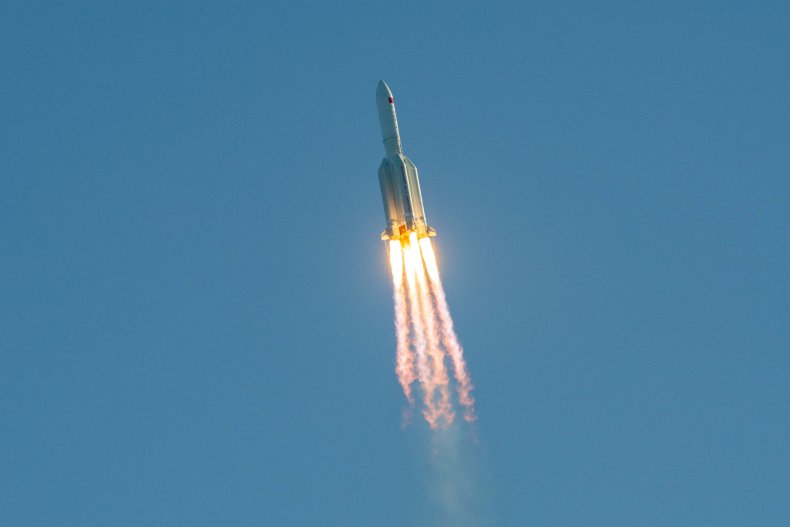How to Track Chinese Rocket Long March 5B That Is Falling to Earth 'Uncontrolled'
A used Chinese rocket is currently tumbling through space and scientists do not know exactly when or where it will return to Earth—but it could be soon.
The rocket, a Long March 5B, was used to place the core module of China's planned Tianhe space station into orbit on April 28.
The rocket released the module but has since been drifting around the Earth, gradually getting lower and lower. It can be tracked using services such as orbit.ing-now, which says it uses third-party data "believed to be reliable."
The rocket has been designated the name 2021-035B.
Even so, it is not possible at the moment to accurately predict when the rocket will re-enter the Earth's atmosphere. This is because it is gradually being slowed by atmospheric drag, but the speed of this process can vary, SpaceNews reports.
Scientists will have a better idea of where the rocket will land as time goes on, Jonathan McDowell, an astrophysicist at Harvard University, told The Guardian. He said the situation is "potentially not good" and "really negligent on China's part."
"Things more than ten tonnes, we don't let them fall out of the sky, uncontrolled, deliberately," he added.
Newsweek has contacted the Chinese government for comment.
The Long March 5B weighs around 20 tons and is roughly 100 feet long and 16 feet wide.
McDowell also posted a tweet, seen below, putting the uncontrolled de-orbit of the rocket into context of other uncontrolled de-orbits, including the much larger NASA Skylab de-orbit in 1979.
Some context for the CZ-5B core stage upcoming reentry. Here are the largest uncontrolled reentries versus time. The y axis is mass in tonnes. STS-107 Columbia is not exactly an uncontrolled reentry but is included for reference in red. The current event is in green. pic.twitter.com/S5ZB2zGqn0
— Jonathan McDowell (@planet4589) May 3, 2021
It is not the first time a Long March 5B rocket has made an uncontrolled re-entry into the Earth's atmosphere. The same thing happened in May last year, when the rocket made its first flight on May 5 and placed a prototype crew capsule into low Earth orbit.
The core stage of the rocket was again left in an uncontrolled orbit, and six days after launch it re-entered the atmosphere. Some parts of that rocket were reported to have survived re-entry and landed in Africa's Côte d'Ivoire.
Jim Bridenstine, NASA Administrator, criticized China at the time for the uncontrolled de-orbit. He said at a committee meeting: "It was seemingly a successful launch until we started getting information about a reentry of a rocket body—a reentry that was really dangerous."
Satellites and other bits of space debris are sometimes left in orbit to eventually reenter the atmosphere, but they usually burn up and never make it to Earth.
Larger spacecraft, such as space stations, do not always completely burn up before they hit the ground. In cases such as these, their atmospheric reentry is usually calculated and pre-determined so that they fall in an area that is as far away from civilization as possible.
When Russia de-orbited its old Mir space station in 2001, it was planned so that it fell into the South Pacific. NASA's Skylab de-orbit in 1979 was not planned, and some bits fell over southern Western Australia.


